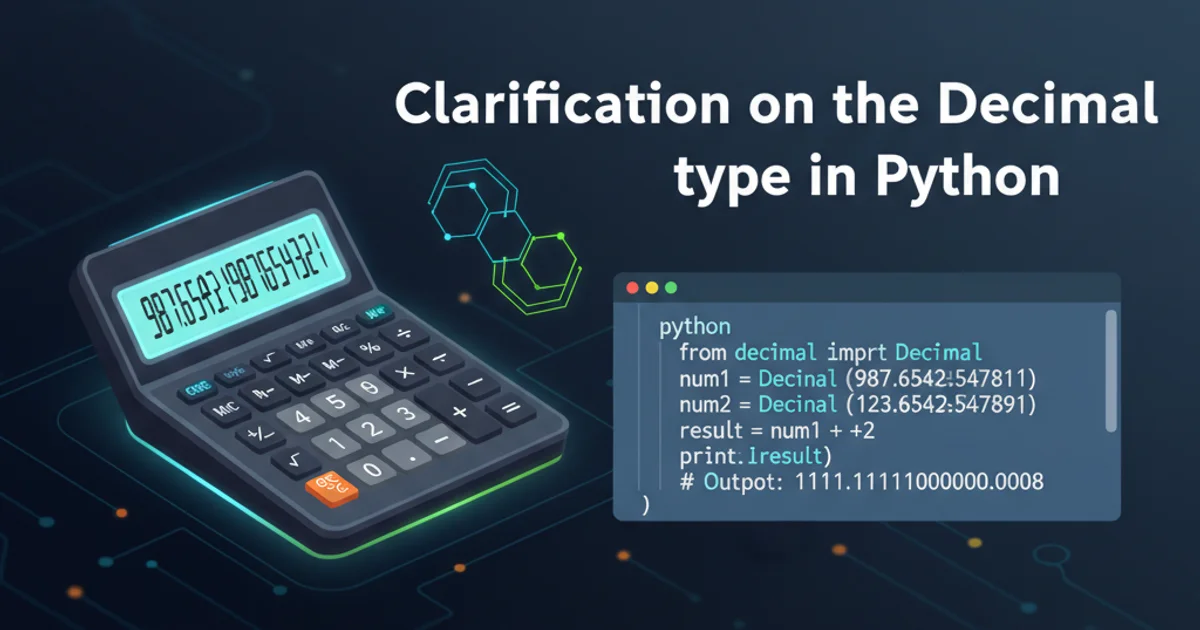Clarification on the Decimal type in Python
Categories:
Understanding Python's Decimal Type for Precise Arithmetic

Explore the Decimal type in Python, its advantages over floating-point numbers for financial calculations, and how to use it effectively to avoid precision errors.
Python's built-in float type, like most programming languages' floating-point implementations, uses binary floating-point arithmetic. While efficient for many scientific and engineering tasks, this representation can lead to unexpected precision issues when dealing with decimal fractions, especially in financial or exact arithmetic contexts. The decimal module provides the Decimal type, offering arbitrary-precision decimal floating-point arithmetic, which is crucial for applications where exact decimal representation is paramount.
The Problem with Floating-Point Numbers
Binary floating-point numbers cannot precisely represent all decimal fractions. For example, the decimal fraction 0.1 cannot be exactly represented in binary. This leads to small, accumulated errors that can become significant in sensitive applications. Consider a simple addition:
print(0.1 + 0.2)
# Expected: 0.3
# Actual: 0.30000000000000004
Demonstration of floating-point inaccuracy in Python.
This seemingly minor discrepancy can cause major headaches in financial systems, where every cent must be accounted for precisely. The Decimal type addresses this by storing numbers as decimal digits, allowing for exact representation of decimal fractions.
Introducing the Decimal Type
The Decimal type from the decimal module provides a way to perform arithmetic with arbitrary precision. It stores numbers as a sequence of decimal digits and an exponent, similar to how we write numbers. This ensures that decimal fractions are represented exactly, eliminating the approximation errors inherent in binary floating-point. To use Decimal, you typically import it and then construct Decimal objects from strings or integers.
from decimal import Decimal
# Creating Decimal objects
decimal_one = Decimal('0.1')
decimal_two = Decimal('0.2')
# Performing addition
result = decimal_one + decimal_two
print(result)
# Expected and Actual: 0.3
# Division with Decimal
decimal_ten = Decimal('10')
decimal_three = Decimal('3')
print(decimal_ten / decimal_three)
# Output depends on context precision, e.g., 3.333333333333333333333333333
Basic usage of Python's Decimal type for precise arithmetic.
Decimal objects from strings, not floats, to avoid initial precision errors. For example, Decimal('0.1') is correct, while Decimal(0.1) would first convert 0.1 to its inexact float representation before creating the Decimal object.Controlling Precision and Rounding
The decimal module allows you to control the precision of calculations and the rounding mode through a context. This is particularly useful for financial calculations where specific rounding rules (e.g., rounding half up, rounding half even) are required. The default precision is 28 digits, but you can change it globally or locally.
from decimal import Decimal, getcontext, ROUND_HALF_UP
# Get the current context
ctx = getcontext()
print(f"Default precision: {ctx.prec}")
# Set global precision and rounding mode
ctx.prec = 4
ctx.rounding = ROUND_HALF_UP
value = Decimal('10') / Decimal('3')
print(f"Value with global context (prec=4, ROUND_HALF_UP): {value}")
# Using a local context for specific operations
from decimal import localcontext
with localcontext() as lc:
lc.prec = 2
lc.rounding = ROUND_HALF_UP
local_value = Decimal('10') / Decimal('3')
print(f"Value with local context (prec=2, ROUND_HALF_UP): {local_value}")
Managing precision and rounding with Decimal contexts.
flowchart TD
A[Start]
A --> B{Need Exact Decimal Arithmetic?}
B -- Yes --> C[Use `decimal.Decimal`]
C --> D[Initialize from Strings: `Decimal('0.1')`]
C --> E[Set Context for Precision/Rounding]
E --> F[Perform Calculations]
B -- No --> G[Use `float` (Default)]
G --> H[Accept Potential Binary Floating-Point Inaccuracies]
F --> I[End]
H --> I[End]Decision flow for choosing between float and Decimal.
Decimal provides exact arithmetic, it comes with a performance overhead compared to float. Use Decimal when precision is critical (e.g., financial calculations), and float when performance is more important and minor inaccuracies are acceptable (e.g., scientific simulations).